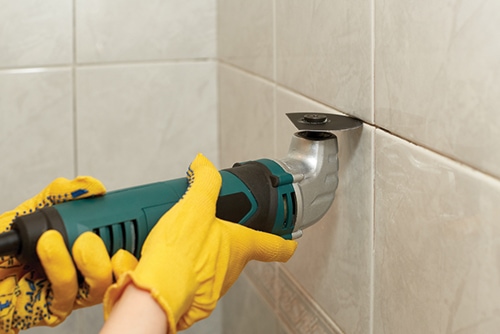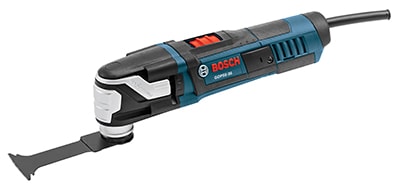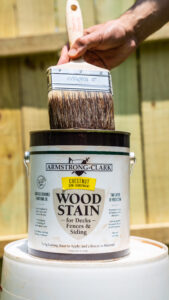By Fran J. Donegan
If you’re like many people, you won’t know you need a multi-tool until you actually have one. They have dozens of uses for all sorts of odd jobs, some of which won’t be apparent until you have the tool in your hand.

Multi-tools are hand-held, corded or battery tools that have oscillating heads. The head moves back and forth in a very tight arc. Fit a cutting blade or some other attachment to the head and you can cut, shear, grind and sand in a very small space. Its small size is one of the reasons it is so useful: It can fit in spaces where larger tools cannot. And the tools can cut through most materials, including wood, drywall, PVC, foam insulation, carpeting, metal and more. If you have a favorite tool manufacturer, there is a good chance they make a line of multi-tools.
Here are some situations where you will find a multi-tool useful.
Removing Hard-to-Remove Materials
When it is time to re-grout a backsplash or a tub surround, use a multi-tool fitted with a grout blade to remove the old material. The thin, rigid blade will fit between tiles, and the mild vibration of the tool makes it easy to control.
To remove carpet adhesive or any hard-to-remove adhesive, use a multi-tool with a scraper blade. They also come in handy for digging hardened caulk from joints.
Working in Tight Spaces
The small handheld design of multi-tools can give you cutting or grinding power in cramped quarters. With a metal cutting blade you can trim copper plumbing lines with ease. You can also use the tool to loosen corroded sink nuts that you can’t get to budge with a wrench. The tools also do a quick job of cutting through the nuts that hold toilets to the floor, as well as the nuts that attach the tank to the bottom part of the toilet.

Making Plunge Cuts
Whether you need to cut through drywall to install an electrical receptacle box or hardwood flooring to install a vent for ductwork, you can make clean cuts without marring the surrounding surface. By plunging the blade right through the face of the material (rather than approaching from an exposed edge), you’ll save material, have less mess to clean up and fewer repairs to make.

Trimming Door Casings and Baseboards
Adding a new floor often means it is necessary to trim the door casings and baseboard to get a professional looking fit. Use a sample of the new flooring as a guide to make the cut. The varying size of the accessory blades gives you the option of using a broad blade to make larger cuts or using a narrow blade for more intricate notches. Blades are available for cutting softwood, hardwood, and a wide range of other materials.

Sanding Detailed or Awkward Areas
You would not use a multi-tool on large surfaces, but you can accomplish detail sanding in very tight spaces. They are also good on narrow areas like window mullions. You’ll find the same range of abrasive grits for multi-tools as you will for other sanding tools.

They’ve earned the name “multi-tools” for the versatility they bring to any number of jobs. A multi-tool probably will not replace your other tools, but in some situations, you may find it is the best tool for the job.
Editor’s Note: Fran Donegan writes home- and garden-related content for numerous digital and print publications. He is the author of the books Pools and Spas and Paint Your Home. To see a wide selection of multi-tools like Fran described, check out Home Depot’s website: homedepot.com
Side Note One
Carbide-Tipped Cutting Blades from Rockwell

A good blade is the business end of any cutting tool, and Rockwell’s new Sonicrafter Extended Life 1-3/8 in. carbide-tipped cutting blade takes oscillating tool performance and durability to new levels. This affordable, premium blade cuts the toughest materials, including ferrous and non-ferrous metals, hardwoods, tile, hardened fillers and more. The versatile new carbide-tipped blade is handy for making long or intricate end cuts, as well as plunge cuts up to 1-5/8 in. deep. It has a stepped profile for efficient flush-cutting, in contrast to flat blades that come at an angle to the work.

In addition, Rockwell offers the Sonicrafter 2-1/2 in. Carbide Grit Semicircle Saw Blade and Sonicrafter Triangular Carbide Grit Rasp Blade. Plus, all of Rockwell’s new carbide-tipped blades feature Universal Fit, which enables them to fit all other competitive oscillating tools. Learn more at www.rockwelltools.com.
Side Note 2
Heavy-Duty Multi-Tools from Bosch
For heavy-duty jobs, the new Bosch StarlockPLUS GOP40-30 oscillating multi-tool includes snap-in, toolless accessory attachment and no-touch blade change with auto-ejection that allows changeout in as little as three seconds. Weighing only 3.3 lbs., the tool offers 4.0-amp power with reinforced metal gearing for optimal force transmission. Its three-degree oscillating arc makes for better accessory utilization and increased productivity. The GOP40-30 accepts standard Starlock and StarlockPLUS heavy-duty accessory ranges.

The top-end, industrial-grade tool in the Bosch oscillating tool line is the GOP55-36. With a powerful 5.5-amp rating, reinforced metal gearing and a large 3.6-degree oscillating arc, this is the most powerful tool in the Bosch Starlock tool line. The GOP55-36 accepts all Starlock-family accessory ranges: standard Starlock, StarlockPLUS and StarlockMAX extreme-duty blades.
For maximum power transmission, the Starlock oscillating tool interface system found on both models was jointly developed by oscillating tool market leaders Bosch and Fein. The system is built around a three-dimensional interface created for high torque transfer and superior performance in the most challenging applications. Accessory changes are tool-free and don’t require the user to even touch the accessory. (The life of the Starlock oscillating tools is maximized by allowing it to accept only the accessories that are suited for it.) Visit boschtools.com.



